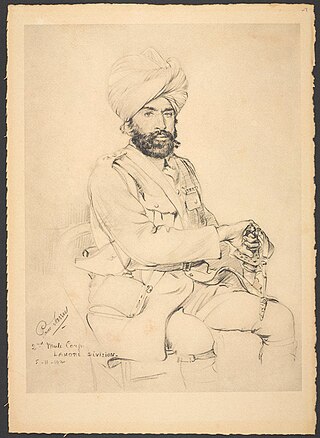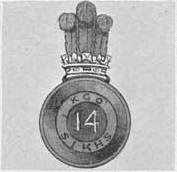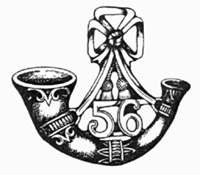Related Research Articles

The Indian Army during British rule, also referred to as the British Indian Army, was the main military force of the British Indian Empire until 1947. It was responsible for the defence of both British India and the princely states, which could also have their own armies. As quoted in the Imperial Gazetteer of India, "The British Government has undertaken to protect the dominions of the Native princes from invasion and even from rebellion within: its army is organized for the defence not merely of British India, but of all possessions under the suzerainty of the King-Emperor." The Indian Army was an important part of the forces of the British Empire, in India and abroad, particularly during the First World War and the Second World War.

The 55th Coke's Rifles (Frontier Force) was a regiment of the British Indian Army. It was raised in 1849 as the 1st Regiment of Punjab Infantry. It was designated as the 55th Coke's Rifles (Frontier Force) in 1903 and became 1st Battalion (Coke's) 13th Frontier Force Rifles in 1922. In 1947, it was allocated to the Pakistan Army, where it continues to exist as 7th Battalion The Frontier Force Regiment.
The 2nd Division was an infantry division of the Indian Army during World War II and was disbanded in 1944. In its present form, 2 Mountain Division, raised in 1962, is part of the Indian Army.

The 12th Frontier Force Regiment was formed in 1922 as part of the British Indian Army. It consisted of five regular battalions; numbered 1 to 5 and the 10th (Training) Battalion. During the Second World War a further ten battalions were raised. In 1945, the prenominal "12th" was dropped when the British Indian Army dispensed with prenominal numbering of its regiments. After the independence in 1947, it was formed into the Frontier Force Regiment, part of the army of Pakistan.
The 10th Indian Division was an infantry division of the British Indian Army during World War I. It was formed in Egypt in December 1914 with three infantry brigades of Indian Expeditionary Force F. After taking part in the Actions on the Suez Canal, the division was dispersed as its brigades were posted away.

The Indian Army, also called the British Indian Army, was involved in World War I as part of the British Empire. Almost 1.5 million Indian troops served overseas, of whom 62,000 died and another 67,000 were wounded. In total at least 74,187 Indian soldiers died during the war.
The 4th (Quetta) Division was an infantry division of the British Indian Army. It was formed by General Kitchener while he was Commander-in-chief of India. During World War I the division remained in India. Its composition was:

The 3rd (Lahore) Division was an infantry division of the Indian Army and before 1895, the Bengal Army, first organised in 1852. It saw service during World War I as part of the Indian Corps in France before being moved to the Middle East where it fought against troops of the Ottoman Empire.
The 11th Indian Division was an infantry division of the British Indian Army during World War I. It was formed in December 1914 with two infantry brigades already in Egypt and a third formed in January 1915. After taking part in the Actions on the Suez Canal, the division was dispersed as its brigades were posted away.
The Bannu Brigade was formed after the 1903 reforms of the British Indian Army by Herbert Kitchener when he was Commander-in-Chief, India. The brigade was part of the Northern Army and deployed along the North West Frontier. In 1914 at the start of World War I the composition of the brigade was:
The Derajat Brigade was formed after the 1903 reforms of the British Indian Army by Herbert Kitchener when he was Commander-in-Chief, India. The brigade was part of the Northern Army and deployed along the North West Frontier. The Derajat Brigade had its winter headquarters at Dera Ismail Khan, and the garrison consisted of a mountain battery, a regiment of Native cavalry, and three regiments of Native infantry. Detachments from these regiments helped to garrison the outposts of Drazinda, Jandola, and Jatta.

The 14th King George's Own Ferozepore Sikhs was a regiment of the British Indian Army; they can trace their origins to the Regiment of Ferozepore formed in 1846. The regiment had a number of different titles over the following years: the 14th Bengal Native Infantry 1861–1864, the 14th Regiment of Bengal Native Infantry 1864–1885, the 14th Regiment of Bengal Native Infantry 1885–1901, the 14th (Ferozepore) Sikh Infantry 1901–1903 and finally, after the Kitchener reforms of the Indian Army in 1903, the 14th Ferozepore Sikhs.

The 15th Ludhiana Sikhs was an infantry regiment in the British Indian Army. They could trace their origins to 1846, when they were known as the Regiment of Ludhiana. During the Indian Mutiny they were relied upon to hold Benares throughout the period of the Mutiny. In 1861, they became the 15th Bengal Native Infantry and shortly afterwards to the 15th (Ludhiana) Regiment of Bengal Native Infantry in 1864. Further changes in title followed they became the 15th Regiment of Bengal Native Infantry in 1885, the 15th (Ludhiana) Sikh Infantry in 1901 and the 15th Ludhiana Sikhs following the Kitchener reforms of the Indian Army in 1903. To honour the visit of the Prince and Princess of Wales to Indian they took part in the Rawalpindi Parade 1905.

The 56th Punjabi Rifles (Frontier Force) was an infantry regiment of the British Indian Army. It was raised in 1849 as the 2nd Regiment of Punjab Infantry. It was designated as the 56th Punjabi Rifles (Frontier Force) in 1906 and became 2nd Battalion 13th Frontier Force Rifles in 1922. In 1947, it was allocated to the Pakistan Army, where it continues to exist as 8th Battalion The Frontier Force Regiment.

The 51st Sikhs (Frontier Force) was an infantry regiment of the British Indian Army. It was raised in 1846 as the 1st Regiment of Infantry The Frontier Brigade. It was designated as the 51st Sikhs (Frontier Force) in 1903 and became 1st Battalion (Prince of Wales's Own Sikhs) 12th Frontier Force Regiment in 1922. In 1947, it was allocated to the Pakistan Army, where it continues to exist as 3 Battalion The Frontier Force Regiment.

The 52nd Sikhs (Frontier Force) was an infantry regiment of the British Indian Army. It was raised in 1846 as the 2nd Regiment of Infantry The Frontier Brigade. It was designated as the 52nd Sikhs (Frontier Force) in 1903 and became 2nd Battalion (Sikhs) 12th Frontier Force Regiment in 1922. In 1947, it was allocated to the Pakistan Army, where it continues to exist as 4th Battalion The Frontier Force Regiment.
The 53rd Sikhs (Frontier Force) was an infantry regiment of the British Indian Army. It was raised in 1847 as the 3rd Regiment of Infantry The Frontier Brigade. It was designated as the 53rd Sikhs (Frontier Force) in 1903 and became 3rd Battalion (Sikhs) 12th Frontier Force Regiment in 1922. In 1947, it was allocated to the Pakistan Army, where it continues to exist as 5th Battalion The Frontier Force Regiment.

The 54th Sikhs (Frontier Force) were an infantry regiment of the British Indian Army. It was raised in 1846 as the 4th Regiment of Infantry The Frontier Brigade. It was designated as the 54th Sikhs (Frontier Force) in 1903 and became 4th Battalion (Sikhs) 12th Frontier Force Regiment in 1922. In 1947, it was allocated to the Pakistan Army, where it continues to exist as 6th Battalion The Frontier Force Regiment.

The 58th Vaughan's Rifles (Frontier Force) was an infantry regiment of the British Indian Army. It was raised in 1849 as the 5th Regiment of Punjab Infantry. It was designated as the 58th Vaughan's Rifles (Frontier Force) in 1903 and became 5th Battalion 13th Frontier Force Rifles in 1922. In 1947, it was allocated to the Pakistan Army, where it continues to exist as 10th Battalion The Frontier Force Regiment.
The 1st (Risalpur) Cavalry Brigade was a cavalry brigade of the British Indian Army formed in 1906 as a result of the Kitchener Reforms. It remained in India during the First World War but took an active part in the Third Anglo-Afghan War in 1919.
References
- ↑ Sumner, p.9
- ↑ "Indian Army 1914". Orbat.com. Archived from the original on 2009-09-09. Retrieved 2009-09-09.